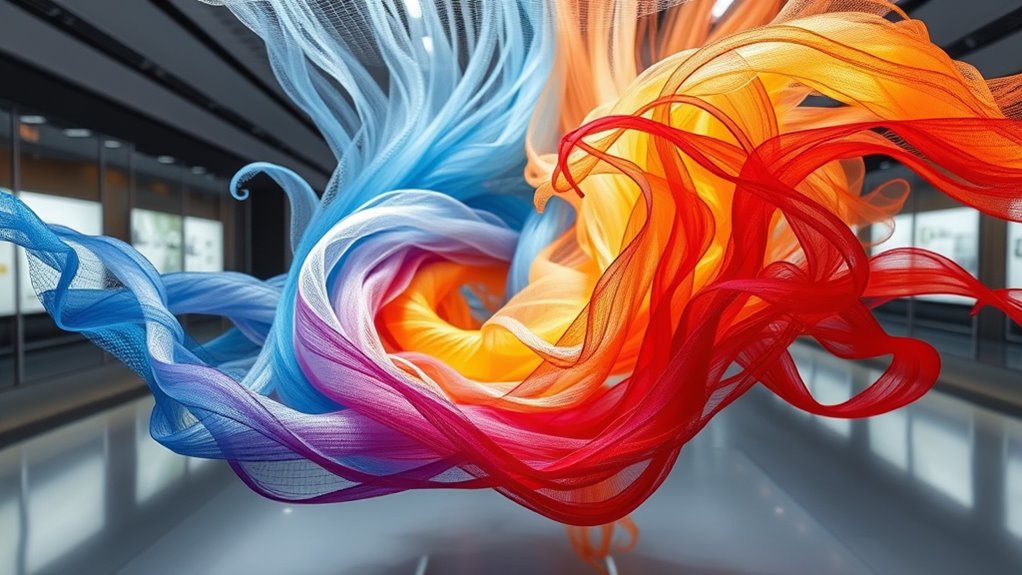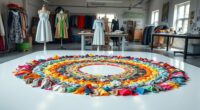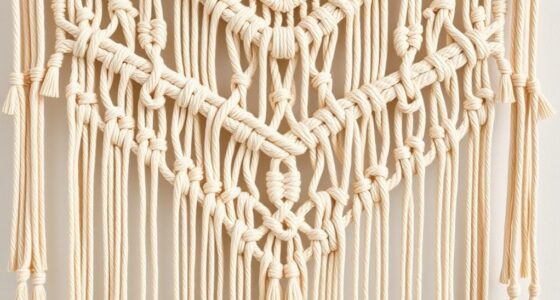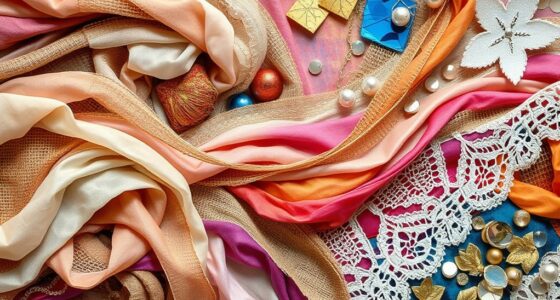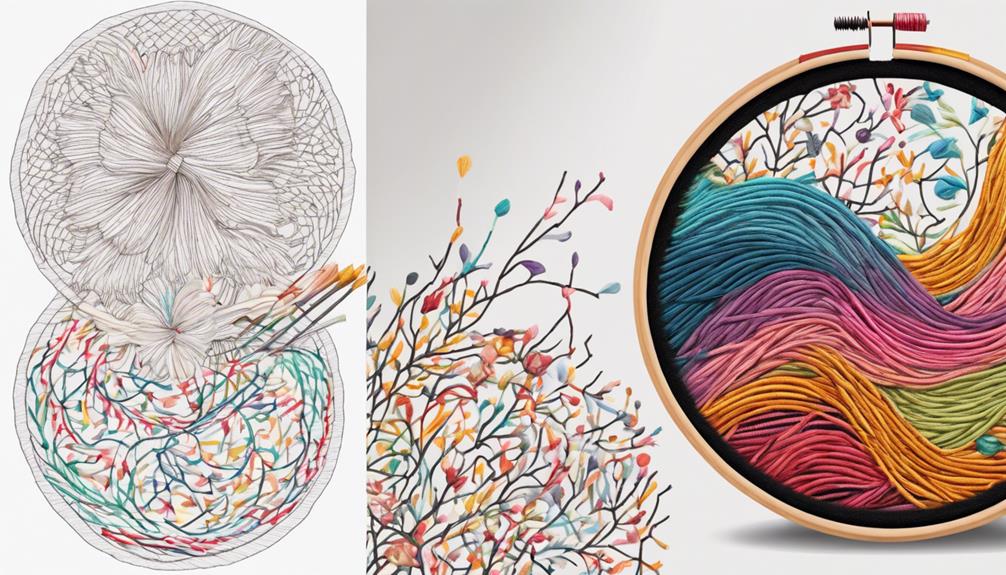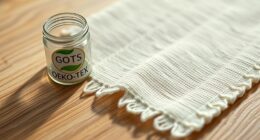AI-driven textile art trends now tap into climate data to create sustainable color palettes, motifs, and patterns. By analyzing environmental factors, AI helps you choose eco-friendly materials and designs inspired by nature’s shifts. This approach not only reduces waste but also aligns your work with sustainability goals. If you continue exploring, you’ll discover how these innovations can transform your textile projects with deeper cultural and environmental insights.
Key Takeaways
- AI analyzes climate data to identify natural color trends inspired by environmental conditions and seasonal changes.
- Machine learning models generate harmonious color palettes based on temperature, humidity, and ecological patterns.
- Climate-driven insights inform sustainable material choices that reflect regional environmental influences.
- AI tools visualize color gradients inspired by weather patterns, enhancing eco-conscious textile design storytelling.
- Integration of climate data into AI-driven design fosters innovative, sustainable textile products aligned with environmental shifts.
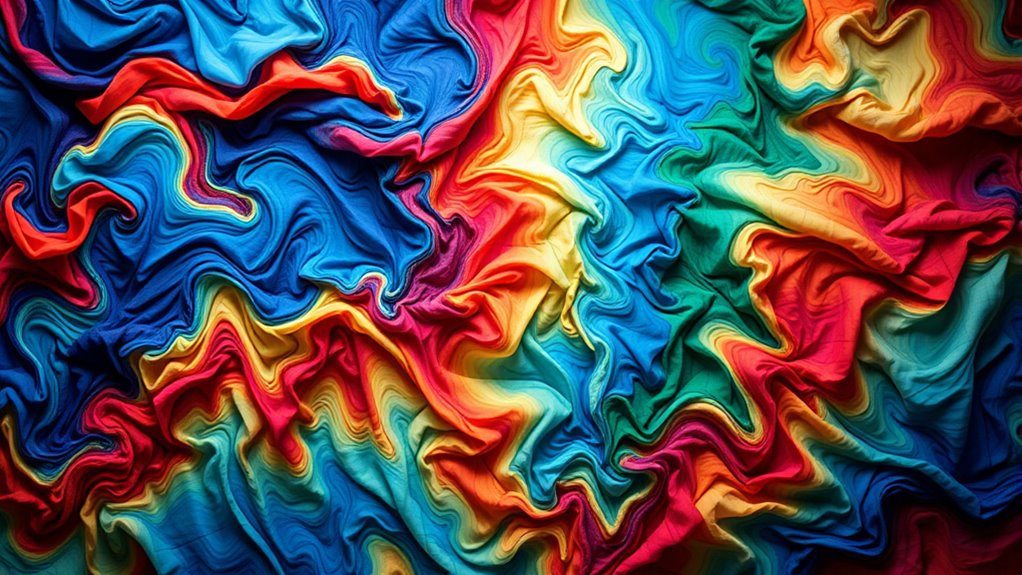
As artificial intelligence continues to reshape the creative landscape, textile artists are increasingly leveraging AI-driven tools to push the boundaries of design and craftsmanship. This technology allows you to explore new frontiers in sustainable materials, making it easier to create eco-friendly textiles that align with environmental goals. By integrating AI, you can analyze data on renewable fibers, biodegradable fabrics, and low-impact dyes, helping you select materials that reduce your ecological footprint. This not only enhances your commitment to sustainability but also inspires innovative approaches to traditional textile practices. AI’s ability to process vast amounts of information empowers you to make informed choices about materials, blending environmental consciousness with artistic expression.
AI empowers textile artists to choose sustainable materials, blending environmental responsibility with innovative craftsmanship.
Cultural influences play a significant role in shaping AI-driven textile art trends. You can tap into diverse cultural motifs, symbols, and techniques by using AI algorithms trained on global datasets. This allows you to incorporate traditional patterns from indigenous communities or historical textile styles into your work, creating a dialogue between the past and present. AI helps you analyze and reinterpret cultural elements, ensuring authenticity while pushing creative boundaries. It also provides a platform for cross-cultural collaboration, where you can blend motifs from different regions to craft unique, culturally rich designs. This fusion of technology and tradition enables you to honor cultural heritage while innovating in your craft.
In addition, AI tools facilitate the customization of textile designs inspired by cultural influences, giving you the power to create highly personalized pieces. You can experiment with motifs, colors, and textures, all informed by cultural contexts, and see instant visualizations. This accelerates your creative process and opens up new possibilities for storytelling through textiles. As you explore these cultural influences, AI can also help you respect and accurately represent cultural symbols, avoiding misappropriation and fostering respectful integration.
Furthermore, AI-driven design processes support sustainable practices by reducing waste. You can generate precise patterns that maximize fabric usage, minimizing excess material. AI also enables you to develop digital prototypes, reducing the need for physical samples and cutting down on material waste. By combining sustainable materials with culturally inspired designs, you create textiles that are both environmentally responsible and culturally meaningful. This synergy not only elevates your craft but also aligns with the growing consumer demand for ethically and culturally conscious products.
In essence, AI empowers you to merge sustainability and cultural influences seamlessly into your textile art. It broadens your creative horizons, encourages responsible material choices, and enriches your designs with meaningful cultural narratives—all while pushing the boundaries of what’s possible in textile craftsmanship.
Frequently Asked Questions
How Accurately Can AI Predict Future Textile Color Trends?
You wonder how accurately AI can predict future textile color trends. AI uses trend prediction models based on vast data accuracy, analyzing consumer preferences, fashion cycles, and cultural shifts. While it’s quite effective at identifying emerging patterns, predictions aren’t foolproof due to unpredictable influences like sudden societal changes. Overall, AI provides valuable insights, helping you stay ahead, but always combine its data with human intuition for the best results.
What Are the Environmental Impacts of Ai-Generated Textile Dyes?
Did you know that traditional textile dyeing consumes over 70% of global freshwater and releases harmful chemicals? AI-generated textile dyes can markedly reduce this impact by promoting sustainable dyeing practices. They enable the development of eco-friendly pigments that require less water and energy, lowering environmental harm. By integrating AI, you can support greener fashion choices, helping to preserve ecosystems while maintaining vibrant, high-quality colors in textiles.
Can AI Customize Patterns for Individual Consumer Preferences?
You can leverage AI’s personalization potential to customize patterns specifically for individual consumer preferences. By analyzing user data and style choices, AI creates unique designs that resonate personally, boosting consumer engagement. This technology allows you to adapt patterns in real-time, ensuring each product feels tailored. Ultimately, AI-driven customization enhances customer satisfaction, fosters brand loyalty, and transforms the way consumers interact with textile art, making shopping more personal and engaging.
How Accessible Is AI Technology for Small Textile Designers?
AI technology has become more accessible for small textile designers, but accessibility barriers and cost implications still exist. You might find affordable tools and platforms that suit your budget, yet advanced features can be pricey. To overcome these challenges, explore free or low-cost AI resources, join online communities, and stay updated on new developments. This way, you can leverage AI to enhance your designs without breaking the bank.
What Ethical Considerations Arise From Ai-Driven Textile Art?
When exploring AI-driven textile art, you should consider ethical issues like intellectual property rights and cultural appropriation. AI might inadvertently use protected designs or imitate cultural symbols without permission. You need to respect original creators and guarantee your work doesn’t exploit or misrepresent cultural elements. By being mindful of these concerns, you can create innovative textile art that’s respectful and ethically sound, avoiding potential legal and cultural conflicts.
Conclusion
As you embrace these AI-driven trends, remember that just as Van Gogh saw beyond the canvas, you can see beyond traditional palettes, transforming climate data into vibrant textiles. Like a modern alchemist, you turn raw information into art that speaks for our planet’s story. Stay inspired, push boundaries, and let technology guide your creativity—because the future of textile art is yours to shape, echoing the timeless dance between innovation and expression.

